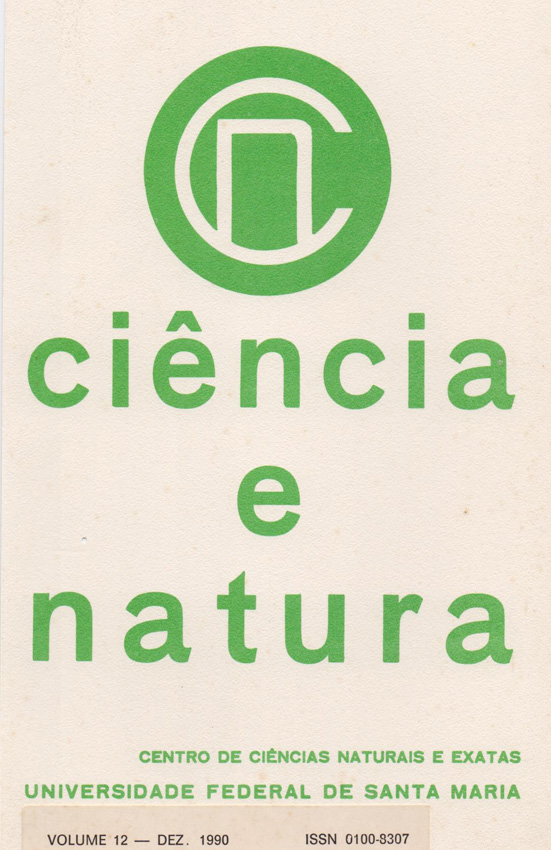Correlação litoestratigráfica das rochas do grupo Itararé no Rio Grande do Sul e sul de Santa Catarina: uma análise preliminar
DOI:
https://doi.org/10.5902/2179460X26191Abstract
O trabalho não apresenta resumo.Downloads
References
BOSSI,G.E & PICCOLI. A.E.M. 1979. lnterpretações paleogeográflcas na Bacia do Paraná, Nordeste do Rio Grande do Sul. I – Grupo Itararé. In: SIMPÓSIO REGIONAL DE GEOLOGIA, 2. Atas. Rio Claro, SP. 1979. 1: 157-74.
DAEMON,R.F. & QUADROS.L.P. 1970. Bioestratigrafia do Neopaleozóico da Bacia do Paraná. In: CONGRESSO BRASILEIRO DE GEOLOGIA. 24. Brasllia DF, 1970. Anis. Brasilia, SBG, 1970. p.359-412.
DELANEY. P.J.U. & GOÑI. J.C. 1963. Correlação preliminar entre as formações gonwânicas do Uruguai e Rio Grande do Sul, Brasil. Boletim Paranaense de Geografia, Curitiba, 8/9:3-21.
FRANÇA, A.B. & POTTER. P.E. 1988. Estratigrafia, ambiente deposicional e análise de reservatório do Grupo Itararé (Permo+Carbonífero), Bacia do Paraná (Parte 1). B. Geoci. Petrobras, Rio de Janeiro. 2(2/4) : 147- 191 .
GUERRA-SOMMER. M.: PICCOLI, A. E. M.; MARQUES-TOIGO, M.; SALDANHA FILHO, P.C. 1985. Estudos integrados de icnocenose associada a molde de lnvertebrado e palinologia em varvitos do Grupo Itararé (Permiano Inferior do Rio Grande do Sul). In: CONGRESSO BRASILEIRO•DE•PALEONTOLOGIA, Fortaleza. Anais... (no prelo).
HOLZ, M.: PICCOLl. A.E.M; VIEIRA. P.E. 1986. Análise estratigrafica das bacias carboníferas do nordeste do Rio Grande do Sul. Gravataí-Morungava Chico Lomã e Santa Terezinha. In: CONGRESSO BRASILEIRO DE GEOLOGIA, 34, Goiânia, 1986. Anais. Goiânia, SBG. V.1, p. 177-90
LOPES,R.C.; LAVINA, E.L.; SIGNORELLI, M. 1986. Facies sedimentares e evolução paleoambiental do Supergrupo Tubarão na Borda Leste da Bacia do Paraná. Uma seção regional nos estados do Rio Grande do Sul e Santa Catarina. In: CONGRESSO BRASILEIRO DE GEOLOGIA, 34. Goiânia, 1986. anais, Goiânia, SBG. v.1, p. 206-18.
MARQUES-TOIGO, M. 1988. Palinologia, bioestratigrafia e paleoecologia do Noepaleozóico da Bacia do Paraná nos estados do Rio Grande do Sul e Santa Catarina, Brasil. Porto Alegre, Curso de Pós-Graduação em. Geociências. 241 p. Tese (Doutorado em Geociências), Instituto de Geociências, UFRGS.
KARQUES-TOIGO, M.; DIAS-FABRICIO, M. E.; GUERRA-SOMMER, M.; CAZZULO-KLEPZIG, M.; PICCOLI, A.E.M. 1989. Afloramentos da área de Trombudo Central, Permiano Inferior, Santa Catarina: Palinologia, icnologia e sedimentologia. In: CONGRESSO BRASILEIRO DE PALEONTOLOGIA, 11, Curitiba, 1989. Resumo das Comunicações. Sociedade Brasileira de Paleontologia, p. 43-44.
PAIM, P.S.G.; PICCOLI, A.E.M.; SARTURI, J.A.D.; HOLZ, M.; MUNARO, P.; GRANITOFF, W. 1983. Evolução paleogeográfica do Supergrupo Tubarão na área de Mariana Pimentel-Faxinal, Guaíba, RS. In: SIMPÓSIO SUL-BRASILEIRO DE GEOLOGIA, 1, Porto Alegre, 1983. Atas, Porto Alegre, SBG, Núcleo RS/SC. p.140-59.
PICCOLI, A.E.M.; PAIM, P.S.G.; SARTURI, J.A.D.; HOLZ, M.; MUNARO, P.; GRANITOFF, W. 1983. Geologia do Supergrupo Tubarão na região de Mariana Pimentel-Faxinal, Município de Guaíba, RS. In: SIMPÓSIO SUL-BRASILEIRO DE GEOLOGIA, 1, Porto Alegre, 1983. Atas, Porto Alegre, SBG Núcleo RS/SC. p. 125-139.
PICCOLI, A.E.M. 1989. Relação estratigráfica entre as fácies Budó e Suspiro (Grupo Itararé) nas folhas de Vila Nova, Lagoa da Meia Lua e Suspiro, RS. Pesquisas, Porto Alegre, n.22, p.45-51.
SCHNEIDER, R.L.; MUHLMANN, H.; TOMMASI,E.; MEDEIROS, R.A.; DAEMON, R.K.; NOGUEIRA, A.A. 1974. Revisão estratigráfica da Bacia do Paraná. In: CONGRESSO BRASILEIRO DE GEOLOGIA, 28, Porto Alegre. Anais, Porto Alegre, SBG. v.1., p. 41-65.
TOMAZELLI, L.J. & SOLIANI JR., E. 1982. Evidência de atividade glacial no Paleozóico Supereior do Rio Grande do Sul, Brasil. In: CONGRESSO BRASILEIRO DE GEOLOGIA, 32, Salvador. Anais, Salvador, SBG, v.4, p.1378-91.
Downloads
Published
How to Cite
Issue
Section
License
To access the DECLARATION AND TRANSFER OF COPYRIGHT AUTHOR’S DECLARATION AND COPYRIGHT LICENSE click here.
Ethical Guidelines for Journal Publication
The Ciência e Natura journal is committed to ensuring ethics in publication and quality of articles.
Conformance to standards of ethical behavior is therefore expected of all parties involved: Authors, Editors, Reviewers, and the Publisher.
In particular,
Authors: Authors should present an objective discussion of the significance of research work as well as sufficient detail and references to permit others to replicate the experiments. Fraudulent or knowingly inaccurate statements constitute unethical behavior and are unacceptable. Review Articles should also be objective, comprehensive, and accurate accounts of the state of the art. The Authors should ensure that their work is entirely original works, and if the work and/or words of others have been used, this has been appropriately acknowledged. Plagiarism in all its forms constitutes unethical publishing behavior and is unacceptable. Submitting the same manuscript to more than one journal concurrently constitutes unethical publishing behavior and is unacceptable. Authors should not submit articles describing essentially the same research to more than one journal. The corresponding Author should ensure that there is a full consensus of all Co-authors in approving the final version of the paper and its submission for publication.
Editors: Editors should evaluate manuscripts exclusively on the basis of their academic merit. An Editor must not use unpublished information in the editor's own research without the express written consent of the Author. Editors should take reasonable responsive measures when ethical complaints have been presented concerning a submitted manuscript or published paper.
Reviewers: Any manuscripts received for review must be treated as confidential documents. Privileged information or ideas obtained through peer review must be kept confidential and not used for personal advantage. Reviewers should be conducted objectively, and observations should be formulated clearly with supporting arguments, so that Authors can use them for improving the paper. Any selected Reviewer who feels unqualified to review the research reported in a manuscript or knows that its prompt review will be impossible should notify the Editor and excuse himself from the review process. Reviewers should not consider manuscripts in which they have conflicts of interest resulting from competitive, collaborative, or other relationships or connections with any of the authors, companies, or institutions connected to the papers.






